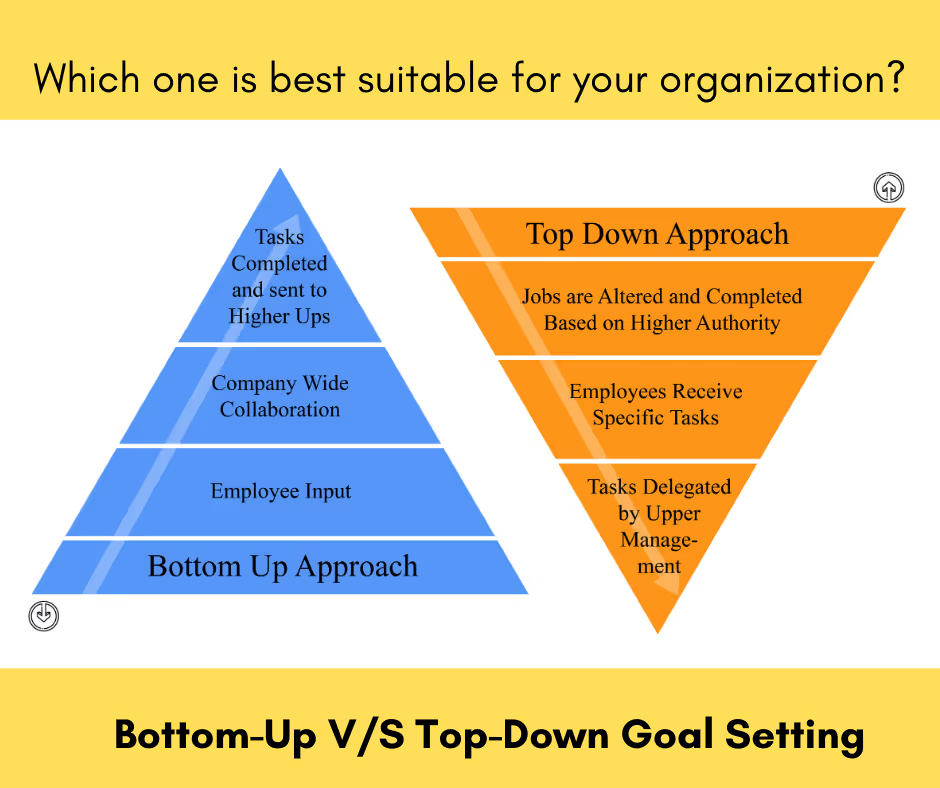
Blog
Top-Down Goals vs Bottom Up Goals: Which is Best for Your Sales Team?
July 19, 2022


Key Insights
How do you define your family values? Conservative, Liberal, or Moderate? Who makes all the decisions in your family? If you’re the youngest of the lot, do you have the freedom to set your own goals? Would it make any difference if you were allowed to set your own goals and make your own decisions?
An organization is no different than a family. There are values, hierarchy, and goals. People associated with it are expected to follow values, respect the hierarchy, and meet the goals. Just like families, some organizations boast traditional values and some follow a liberal or perhaps, moderate approach. Regardless of the values and the structure one decides to follow, the objective remains the same — to ensure that all members of the establishment contribute to its success and welfare.
So how does one realize this objective?
Simple, by working on the goals that are either set by someone else (majorly the top management), or by setting one’s own goals.
In an organizational structure, the goal-setting activity is carried out under two different methods — top-down and/or bottom-up.
Regardless of whether you are overseeing a sales department or working in the execution space, acquiring a comprehensive understanding of different facets of goal-setting is crucial. Such knowledge will enable you to develop a system that aligns with the company's objectives, ultimately leading to enhanced success, increased revenue, and improved work satisfaction.
Welcome to the world of Goal-Setting!
Goals, as defined by Latham & Locke in their famous book, “ Theory of Goal Setting and Task Performance” are “the object or aim of an action to attain a specific standard of proficiency, usually within a specified time limit”. Organizational goals inform employees where the organization is going and how it plans to get there.
On the other hand, goal setting is an activity carried out by organizations to align individual goals with that of the organization.
As mentioned earlier, most organizations follow either a Top-down approach or a Bottom-up approach for setting objectives with measurable results.

Top-Down Approach
What does the organization want to achieve? What’s the long term vision?
Example of a Top-Down Approach Goal Setting: To decrease customer turnover rate by 7% by the end of the quarter.
The top-down approach to goal setting is where the top management (such as CEOs) identifies the strategic goals to support the organizational mission, including those related to Incentive Compensation Management. These strategic goals are then passed down to the mid and operating level managers. It’s the job of the team manager to break down broad goals assigned by the top management into small objectives for their team.
In simple terms, the “Big Boss” tells you what needs to be accomplished. It’s you who have to accomplish the goals with the help of your team.
Studies suggest that about 50 percent of the Fortune 500 companies currently use or have used the Top-Down Approach. This approach works well for people or teams that are new in the organization and need close supervision to meet their goals.

Bottom-up Approach
How many people a team would need to meet the annual sales goal? What can we create with the tools and resources available at present?
Example of a Bottom-up Approach Goal Setting: How can we use the new programming language Python to create a fresh line of SaaS products.
When it comes to the Bottom-Up Approach for goal-setting, you need to look no further than the most successful innovator of the century — Google! The “20 percent time” is the company’s initiative to encourage engineers to work on something that both company and the individual can benefit from. This means that if you have a great idea, you always have time to run with it. Gmail Adsense, Google News, and GTalk — were all born out of 20 percent time.
So how does it work? Individuals at the bottom of the hierarchy set the goals and objectives for their team and send them to the top level for review. A bottom-up approach for goal setting focuses specifically on the product or service one is trying to sell and gathers details around it to make an accurate sales projection. This projection is then shared with the top management for the final sign off.
Goals determined with this system are likely to be more realistic than those set at the top of the organization. They are more flexible and encourage employee engagement at all levels. Integrating effective Sales demo duties and responsibilities ensures a comprehensive approach, aligning individual goals with broader organizational strategies for enhanced performance and success.
How can the incentive theory of motivation enhance these approaches? Read more about it at The Incentive Theory of Motivation: Exploring, Implementing, Types.
The Right Fit for your Business

For many years, organizations followed a top-down approach for goal-setting. All goals were created on the basis of the information the top-level managers had, without taking into account the experience and the situations of the people working at different levels to realize those goals. Of course, the approach more often than not fails to provide the expected results on many occasions.
To overcome this limitation, a more modern goal-setting technique, the bottom-up was introduced. This approach focuses on encouraging lower-ranking employees to contribute to organizational missions and objectives more frequently. Over the years, there was a significant trend upwards in the use of the bottom-up approach for goal-setting.
Why the Bottom-up approach makes more sense? Operating employees have a better understanding of the customers and their expectations. Their regular interactions with customers help them determine accurate unit performance goals in line with the organization’s mission.
In my experience with various organizations, however, what makes the bottom-up approach work better than the top-down approach is the level of engagement that employees are exposed to. They not only feel valued, but also empowered to personally succeed in a way that leads to the success of the organization. This approach also makes them more accountable in every task they handle, creating a more connected culture and a better employee experience. Hence, the low employee turnover rate.
But a bottom-up approach to goal setting does not mean that senior managers are “not needed”. In fact, they play a very crucial role in the process, primarily working as a bridge between both the top management and operating employees. Their job is to analyze and review each goal and facilitate the process.
To remain competitive today, organizations that empower their employees by delegating authority and decision-making witness stronger job performance, job satisfaction, and commitment to the organization. When done right, deploying an effective goal-setting approach can benefit both the employees and the organization.
Cross-functional team management tips:
When implementing either top-down or bottom-up goal setting, effective cross-functional team management is crucial for success. Here are some tips:
- Build relationships outside the management team: Encourage team members to develop strong relationships with colleagues from other departments.
This fosters collaboration and breaks down silos, leading to better communication and problem-solving.
- Facilitate cross-team communication: Establish clear communication channels and processes to ensure that information flows smoothly between teams.
This includes regular meetings, shared project management tools, and open communication platforms.
- Supplement with additional forms of feedback: Don't rely solely on formal performance reviews.
Encourage regular feedback from peers, managers, and customers to provide a well-rounded view of performance and identify areas for improvement.
This ensures that the goals are being met, and if not, allows for fast adjustments.
Benefits of Top-Down Approach:
- Clarity of goals and objectives: Top-down goals provide a clear and consistent direction for the entire organization. Employees understand how their work contributes to the overall strategic objectives.
- Streamlined Communication: Communication is more efficient as goals are cascaded down from leadership. This reduces ambiguity and ensures everyone is on the same page.
- Efficient Resource Allocation: Leadership can allocate resources more effectively based on the organization's strategic priorities.
- Encouraging collaboration: Top-down can still encourage collaboration, when the goals are broken down and require cross functional team work.
- Better control and oversight: Managers have greater control over the goal-setting process and can monitor progress closely.
Drawbacks of Top-Down Approach:
- Dependence on upper management: This approach can create a dependency on upper management, potentially slowing down decision-making.
- Lack of employee engagement: Employees may feel less engaged if they have limited input into the goal-setting process.
- Lack of organizational agility: Top-down goals can be less flexible and adaptable to changing market conditions.
Benefits of Bottom-Up Approach:
- Greater buy-in and commitment: Employees are more likely to be committed to goals they helped create.
- Enhanced creativity and innovation: This approach encourages employees to contribute their ideas and expertise, leading to more innovative solutions.
- Better decision-making: Employees with local insights can provide valuable input into goal setting.
- Employee empowerment and local insights: Employees feel empowered when their opinions are valued and incorporated into the goal-setting process.
Drawbacks of Bottom-Up Approach:
- Inconsistency: Goals may vary significantly between teams, leading to inconsistency across the organization.
- Less control: Managers have less control over the goal-setting process and may find it challenging to align individual goals with organizational objectives.
- Lack of vision: With out a clear over arching vision, goals can become to specific, and lack the ability to move the company forward as a whole.
ReKennect : Stay ahead of the curve!
Subscribe to our bi-weekly newsletter packed with latest trends and insights on incentives.
Thank you! Your submission has been received!
Oops! Something went wrong while submitting the form.
Your data is in safe hands. Check out our Privacy policy for more info






%20(1).avif)









